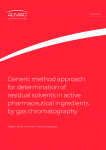Inside the FDA's Accelerated Approval: How it’s extending lives and improving patient care

Ginny brings a wealth of knowledge and experience to the table from her diverse background in nursing, law, and regulatory policy. The conversation delved into the intricacies of global regulatory practices and the importance of collaboration in the industry.
Liza Laws (LL): Thanks for joining me, Ginny. Could you start by introducing yourself and explaining your current role?
Ginny Beakes-Read (GBR): Certainly, I serve as the head of global regulatory policy and intelligence at Johnson & Johnson. My background includes experience as a nurse and an attorney. After some practical nursing experience and legal work, I joined the FDA, where I spent eight years developing regulations and addressing policy issues, including accelerated approval. Since 2005, I’ve been in the industry, focusing on regulatory policy.
LL: That's very interesting. Let's dive into the FDA’s Accelerated Approval Program (AAP). Can you provide an overview and its primary objectives?
GBR: The AAP was developed in 1992 in response to the AIDS crisis. Its goal is to expedite access to lifesaving or life-extending products for patients with serious diseases. It allows for approval based on surrogate endpoints that predict clinical benefit, ensuring patients receive needed treatments more quickly, while the ultimate clinical benefit is confirmed post-approval.
LL: Your recent study estimated the FDA’s AAP helped gain approximately 263,000 patients’ life years from 2016 to 2022. Could you elaborate on the methodology used?
GBR: We employed survival modeling to compare the overall survival benefit of patients receiving therapies under accelerated approval versus standard care. This involved analyzing patient uptake and survival data, ensuring we captured the clinical impact of these therapies over a defined period.
LL: The study suggests extending the timeline to 2026 could increase patient life years to 382,000. What factors contribute to this projected increase?
GBR: While these are projections and subject to change, many therapies included in the study were approved recently, meaning we didn't capture their full impact within the study period. Extending the timeline allows for a more comprehensive analysis of their long-term benefits.
LL: Can you discuss the subgroup analysis findings, particularly for therapies with orphan designations?
GBR: Orphan drugs typically address conditions with limited treatment options. The analysis showed significant benefits for these therapies, as they often provide the first effective treatment for these patients, leading to considerable gains in life years compared to standard care.
LL: The study included therapies with various outcomes, including withdrawals. How does this approach affect the conclusions about the program's efficacy?
GBR: Including all therapies, even those withdrawn, provides a comprehensive view of the program's impact. Overall, the program showed a positive effect on survival, indicating that even withdrawn products contributed positively to certain cases.
LL: There’s concern that restricting the AAP could hinder access to life-saving treatments. Can you provide examples where patient outcomes might have been significantly worse without the AAP?
GBR: Take multiple myeloma, for example. Accelerated approval has helped extend survival to up to 10 years. Without these approvals, patients might not have had access to effective treatments during crucial times, potentially leading to worse outcomes.
LL: What are the primary regulatory challenges associated with the AAP, and how can these be addressed?
GBR: The AAP framework is effective but can always improve. Continuous collaboration among stakeholders and refining the process are key. Congress has reinforced this pathway twice, indicating its importance. Ongoing adjustments will help optimize its effectiveness.
LL: How do you foresee the role of the AAP evolving in the next decade, particularly with advances in oncology and other therapeutic areas?
GBR: As science and technology advance, our understanding of diseases and treatment endpoints improves. This will enhance the AAP’s ability to deliver innovative products to patients, ensuring continued alignment with scientific progress.
LL: How do regulatory frameworks like the AAP support innovation in drug development?
GBR: Regulatory frameworks must be agile and supportive of innovation. My background as a critical care nurse has shown me the urgent need for effective therapies. The AAP fosters this by providing a pathway for rapid development and approval of innovative treatments.
LL: What motivates you personally to advocate for programs like the AAP?
GBR: My experiences as a nurse drives my passion. Seeing patients in need of effective treatments inspires me to support frameworks that deliver life-saving therapies. It's about providing hope and improving lives.
LL: How important is collaboration between regulatory bodies, pharmaceutical companies, and patient advocacy groups in optimizing programs like the AAP?
GBR: Collaboration is crucial. Regulatory bodies, companies, and advocacy groups must work together to ensure these programs meet patient needs without compromising safety. This collective effort drives the success and evolution of the AAP.
LL: How does real-world evidence integrate into your study, and what role does it play in future policy recommendations?
GBR: Real-world evidence is vital. Our study used various data sources, including real-world data, to ensure robust evidence of overall survival. This comprehensive approach helps us understand the true impact of therapies and informs future policy decisions.
LL: What best practices from the FDA’s AAP could be applied to other regulatory environments worldwide?
GBR: Focusing on clinical impact and patient uptake is key. Global regulators should consider these aspects to understand the true benefits of therapies. Collaboration and shared learning can enhance global health outcomes.
LL: How crucial is global collaboration in optimizing a widely impactful program?
GBR: Optimizing the program with global collaboration is really important. This program affects so many people, and that's why people are talking about it a lot because we're addressing such a big need. We want to get it right. We want to manage risk and uncertainty. The product has full approval; it meets the legal standard, but there's still some uncertainty to be confirmed. So global collaboration is crucial. Working with different stakeholders is vital to focus on what we're trying to accomplish and getting stakeholder input on the impact of the program. It's always healthy to have a debate from all different stakeholders, but we all should be aligned on our goals and really home in on that.
LL: Why is it essential to emphasize getting it right with large-scale programs?
GBR: With a program of this magnitude, impacting so many lives, the emphasis on getting it right is paramount. While the product has full approval and meets legal standards, there remains some uncertainty to be confirmed, necessitating ongoing global cooperation. Engaging various stakeholders to focus on the program's objectives and impacts is essential, and having robust debates among stakeholders can ensure alignment on our goals and a more precise focus.
LL: Why is expedited drug approval important for certain conditions?
GBR: Another decade is a substantial amount of time, and that's something to strive for. With accelerated approval, some might say the drug would just be studied longer. But that's not always the case. Not everyone has the capital or the time. Some studies, especially for fast-growing conditions or difficult-to-treat cancers, need to be expedited. Each relapse reduces hope.
Oncology was one area where efforts were made to ensure treatments continued despite COVID. People wanted to help. Early intervention is key to better outcomes.





























